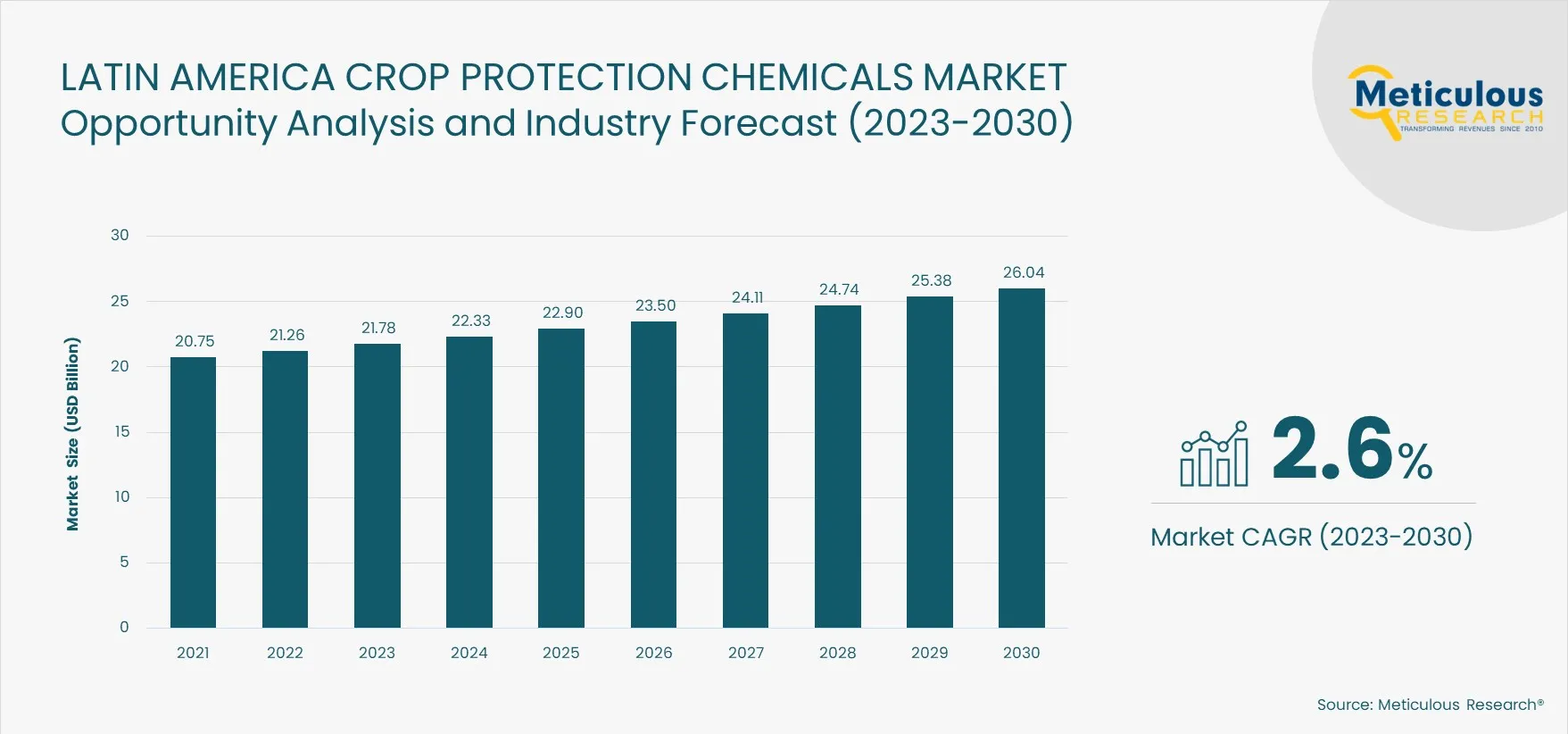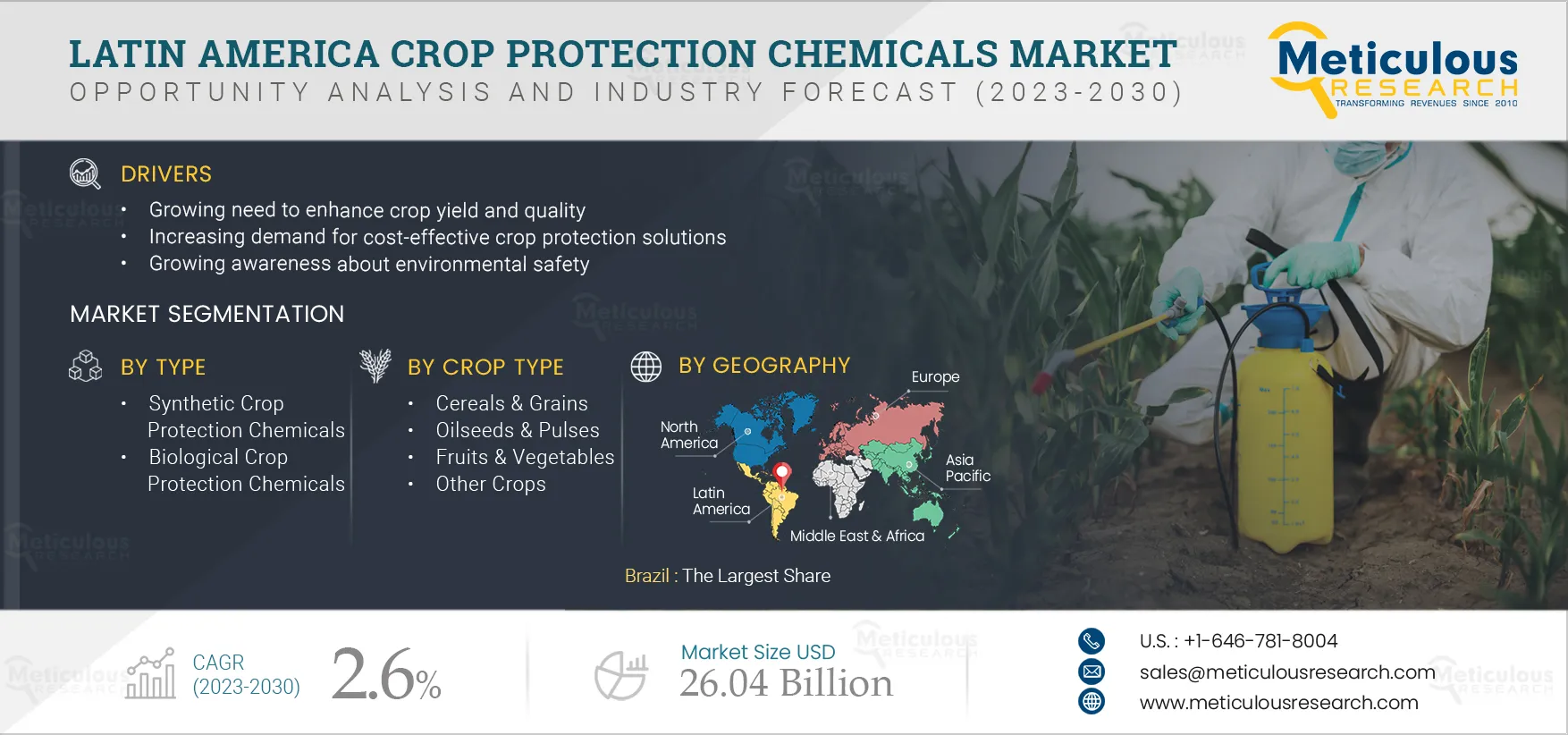The Latin America Crop Protection Chemicals Market is expected to reach $26.04 billion by 2030, at a CAGR of 2.6% from 2023 to 2030. While in terms of volume, the market is expected to reach 3,681,637.4 tons by 2030, at a CAGR of 2.2% from 2023 to 2030. The growth of this market is driven by the growing need to enhance crop yield and quality, the increasing demand for cost-effective crop protection solutions, the growing awareness about environmental safety, and the decrease in arable land.
Here are the top 10 companies operating in the Latin America Crop Protection Chemicals Market
Founded in 2000 and headquartered in Basel, Switzerland, Syngenta is a global provider of agricultural science and technology. The company operates through two segments: Crop Protection and Seeds. The crop protection segment provides fungicides, herbicides, plant growth regulators, seed treatment, and insecticides. The company operates in the high-value commercial sectors of field crops (including corn, oilseeds, cereals, and sugar beet) and vegetables.
With its subsidiary and strong distribution network in more than 100 countries, the company has a geographical presence in North America, Europe, Asia-Pacific, Latin America, and the Middle East & Africa.
Bayer AG (Germany)
Founded in 1863 and headquartered in Leverkusen, Germany, Bayer is an agro-tech company that emphasizes the development of technology in agriculture by providing crop protection, biotechnology research, and agriculture technology solutions to farmers in transforming their farming business. The company operates through three business segments: Pharmaceuticals, Crop Science, and Consumer Health. The company operates in the crop protection chemicals market through its Crop Science segment. Its product portfolio comprises crop science services in seeds, crop protection, non-agricultural pest control, and several chemicals and biological crop protection products and solutions, including fungicides, herbicides, insecticides, seeds, and seed growth solutions, and services for sustainable agriculture.
With its subsidiaries and strong distribution network in more than 83 countries, the company has a geographical presence across North America, Europe, Asia-Pacific, Latin America, and the Middle East & Africa.
Founded in 2019 and headquartered in Indiana, U.S., Corteva became an independent public company on June 1, 2019, and was previously the Agriculture Division of DowDuPont. The company offers seeds and crop protection products, software solutions, and digital services. Corteva operates through two segments: Seed and Crop Protection. Its Crop Protection segment offers herbicides, fungicides, insecticides, nematicides, biologicals, and seed-applied technologies. The company also offers various natural products, such as biologicals. The biologicals portfolio from Corteva helps farmers meet these standards with products that can often be used right up until harvest to control diseases and pests when maximum residue limits are a concern.
With its subsidiaries and a strong distribution network in more than 140 countries and 100 manufacturing and production units, the company has a geographical presence across North America, Europe, Asia-Pacific, Latin America, and the Middle East & Africa.
BASF SE (Germany)
Founded in 1865 and headquartered in Ludwigshafen, Germany, BASF is involved in the manufacturing and supplying of various products. The company operates through six business segments: Chemicals, Materials, Industrial Solutions, Surface Technologies, Nutrition & Care, and Agricultural Solutions. The company provides crop protection chemicals, such as fungicides, insecticides, herbicides, seed treatment, and biological solutions through its Agricultural Solutions segment. The company also provides its products to various industries, such as petrochemicals, coatings, chemicals, food, industrial, and agriculture.
With its subsidiaries and strong distribution network in more than 90 countries, the company has a geographical presence across North America, Europe, Asia-Pacific, Latin America, and the Middle East & Africa.
Founded in 1969 and headquartered in Mumbai, India, UPL is engaged in the manufacturing and marketing of agrochemicals, industrial chemicals, chemical intermediates, and specialty chemicals across the globe. The company operates through six business segments: Seeds, Crop Protection, Plant Stress and Simulation, Post-Harvest Solutions, Aquatics, and Soil Health and Water Technologies. Its crop protection business segment offers various products, including soil and seed health, fungicides, herbicides, ProNutiva, Insecticides Adjuvants, and acaricides. In October 2013, the company changed its name from United Phosphorus Limited to UPL Limited.
With 44 manufacturing facilities and 1,238 product formulations, the company has a geographical presence in more than 138 countries across North America, Europe, Asia-Pacific, Latin America, and the Middle East & Africa.
FMC Corporation (U.S.)
Founded in 1883 and headquartered in Pennsylvania, U.S., FMC Corporation is a chemical company that specializes in agricultural crop protection products. The company’s agricultural solutions segment develops, manufactures, and sells crop protection solutions, including both synthetic and biological, such as insecticides, herbicides, fungicides, and biostimulants that are used in agriculture to enhance crop yield by controlling a range of insects, weeds, and diseases, as well as in non-agricultural markets for pest control. The company operates through five business segments: Insecticides, Herbicides, Fungicides, Plant Health, and Others.
FMC operates in more than 50 countries and has a geographical presence across North America, Europe, Asia-Pacific, Latin America, and the Middle East & Africa.
Founded in 2000 and headquartered in Bagsværd, Denmark, Novozymes is a biotechnology company that focuses on researching, developing, and producing industrial enzymes, microorganisms, and biopharmaceutical ingredients. The company operates through five segments: Household Care; Food, Beverages & Human Health; Bioenergy; Grain & Tech Processing; and Agriculture, Animal Health & Nutrition. The company offers several microbial solutions derived from naturally occurring microbes, such as bacteria and fungi, through the crop protection business of the Agriculture, Animal Health & Nutrition segment.
The company has a strong geographical presence across North America, Europe, Asia-Pacific, Latin America, and the Middle East & Africa.
Sumitomo Chemical Co., Ltd. (Japan)
Founded in 1913 and headquartered in Tokyo, Japan, Sumitomo Chemical is a chemical company that offers a diverse range of chemical products. The company operates through five business segments: Essential Chemicals & Plastics, Energy & Functional Materials, IT-related Chemicals, Health & Crop Sciences, and Pharmaceuticals. The company offers crop protection chemicals through its Health & Crop Sciences business segment. The Health & Crop Sciences segment manufactures and sells crop protection chemicals, fertilizers, feed additives, household insecticides, products to control infectious diseases, and active pharmaceutical ingredients and intermediates.
With its subsidiaries and a strong distribution network, the company has a geographical presence across North America, Europe, Asia-Pacific, Latin America, and the Middle East & Africa.
Founded in 1916 and headquartered in Melbourne, Australia, Nufarm develops, manufactures, and sells crop protection solutions, including herbicides, insecticides, and fungicides, that protect crops against weeds, pests, and diseases. The company operates through two business segments: Crop Protection (Non-selective Herbicides, Other Selective Herbicides, Phenoxies, Fungicides, and Insecticides) and Seed Technology. The crop protection segment deals in manufacturing and selling crop protection products used by farmers to protect crops from damage caused by weeds, pests, and disease.
The Seed Technologies segment deals with the seed treatment portfolio and the Nuseed business. The seed treatment products offered by the company provide protection and treatment for damage caused by insects, fungi, and plant diseases. The company’s offerings focus on five core crops: cereals, vines and vegetables (trees, nuts), corn, pasture (turf & ornamental), and soybean.
With its subsidiaries and a strong distribution network, the company has a presence across North America, Europe, Asia-Pacific, Latin America, and the Middle East & Africa.
American Vanguard Corporation (U.S.)
Incorporated in 1969 and headquartered in California, U.S., American Vanguard is a diversified specialty and agricultural products company. The company develops and markets products for crop protection and management, turf and ornamentals management, and public and animal health. The company’s products include insecticides, fungicides, herbicides, soil health, plant nutrition, molluscicides, nematicides, and soil fumigants, which are marketed in liquid, powder, and granular forms.
With its subsidiaries and a strong distribution network, the company has a geographical presence across North America, Europe, Asia-Pacific, Latin America, and the Middle East & Africa.

























